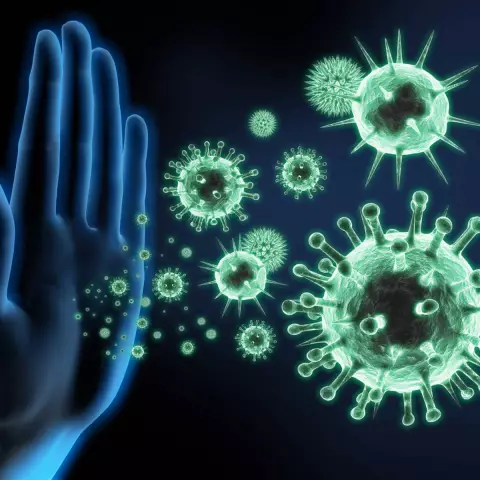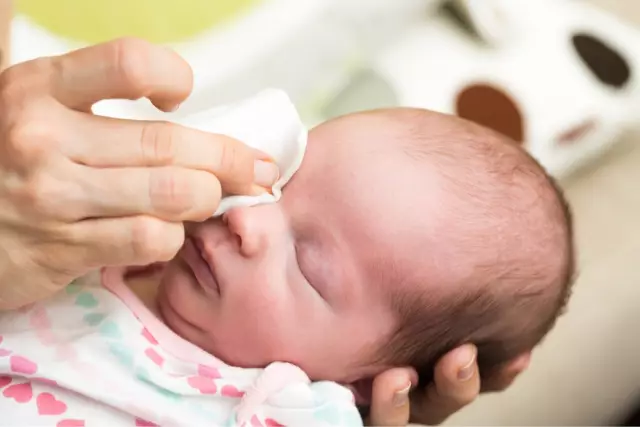- Author Curtis Blomfield [email protected].
- Public 2023-12-16 20:44.
- Last modified 2025-01-23 17:01.
Consider the symptoms and treatment of tracheitis in children. What is this pathology, how is it treated?
Children's tracheitis is a respiratory pathology characterized by inflammatory and infectious effects on the trachea of various origins. In a child, tracheitis passes with bouts of dry cough, fever, soreness behind the sternum. Its diagnosis is based on the information of the clinical picture, laryngoscopy, auscultation and tracheobronchoscopy. Treatment of tracheitis in a child includes the use of antibacterial, antiviral or etiotropic drugs, expectorants; physiotherapy (UHF, inhalations, inductothermy, electrophoresis), rubbing the chest, mustard plasters.

Why does tracheitis appear in children?
In a child, acute tracheitis most often has a viral origin: it is mainly caused by parainfluenza, influenza, respiratorysyncytial virus, adenoviruses, etc.
Children's bacterial tracheitis most often develops after trauma to the trachea or a viral infection caused by a foreign object, recent intubation, and other causes. Among the bacterial agents, the etiological role of staphylo-, pneumo- and streptococcus, moraxella, hemophilic infection, etc. was determined.
Chlamydial and mycoplasmal lesions of the respiratory tract are often found, mixed infection - bacterial-viral, viral-mycoplasmal and others.
Fungal tracheitis or tracheomycosis caused by actinomycosis, aspergillosis, candidiasis is rare in children.
In a child, tracheitis can develop in the presence of infectious diseases that occur with damage to the upper respiratory tract (scarlet fever, measles, diphtheria, whooping cough, etc.), that is, it can be secondary. Allergic tracheitis develops with increased sensitization of the child's body to fungal, drug and food allergens, as well as house dust.

Tracheitis in children progresses due to inhalation of cold, dusty or dry air, active and passive smoking, hypothermia, nasal breathing disorders (with adenoids, deviated nasal septum, hypertrophic rhinitis, etc.), chronic infection (multiple caries, sinusitis, tonsillitis).
Chronic or prolonged course of tracheitis is most often observed in patients with rickets, hypovitaminosis, malnutrition, diathesis, impaired immunity.
Treatment of tracheitis in a child will be discussed below.
Varieties of children's tracheitis
According to the peculiarities of the clinical course, acute and chronic tracheitis is distinguished. By origin in a child, tracheitis can be both primary (that is, an independent pathology) and secondary (that is, the main infection manifests itself). From a combination with disorders of other parts of the respiratory tract, children's tracheitis can take the form of tracheobronchitis, laryngotracheitis, rhinopharyngotracheitis.
According to changes in the trachea of a pathomorphological nature that develop in chronic lesions, a hypotrophic form is distinguished, when the vessels expand and the mucous membrane swells, an atrophic form (the mucous membrane becomes thinner). Depending on the cause of the appearance, there is an allergic and infectious (fungal, bacterial, viral, mixed) tracheitis in a child.

Signs of childhood tracheitis
Children's tracheitis most often begins like a simple viral infection: there are pain and sore throat, runny nose, general weakness, reflex cough, fever and headaches. The pathognomonic symptom of tracheitis in a child is a painful, dry and paroxysmal cough, predominantly appearing at night or almost immediately after waking up.
Cause of paroxysmal coughing can be crying, deep breathing, temperature changes (for example, when leaving the room outside). Coughing fits can last from a few minutes to several hours, oftenaccompanies vomiting.
During and after a coughing attack, there is a raw, dull pain and burning sensation between the shoulder blades and behind the sternum. Children are afraid to cause another attack and therefore limit the depth of their breath, in connection with which their breathing becomes superficial and rapid. With a cough attack, intercostal retractions appear, that is, the muscles move. Treatment of tracheitis in a child of 3 years old should be timely. Why is this important?
At the stage of catarrhal dry tracheitis, sputum is coughed up with difficulty, most often it looks like mucous viscous lumps. After a few days, this secret becomes purulent-mucous and separates more freely, and therefore the cough no longer causes pain to the patient.
Signs of subglottic tracheitis are similar to the clinic of children's laryngitis. This form of pathology is accompanied by a "barking" obsessive cough, sore throat, hoarse voice, when the inflammatory process passes to the larynx, it can be complicated by stenosing laryngotracheitis (false croup).
Chronic form
Chronic tracheitis disturbs the child with constant coughing during the daytime and obsessive coughing attacks at night, voice disorders in the form of dysphonia, general weakness, subfebrile condition.
Especially dangerous is the flow of tracheitis in infants, because due to the underdevelopment of the cough reflex, the baby is not able to cough up sputum productively. Tracheitis in a child in this case can be complicated by bronchopneumonia, tracheobronchitis, bronchiolitis and respiratory failure, even to asphyxia.

The symptoms and treatment of tracheitis in a child are often associated. Komarovsky is a well-known pediatrician - this confirms.
Diagnosis of childhood tracheitis
Children's tracheitis is diagnosed on the basis of auscultatory, clinical, laboratory and endoscopic parameters. In addition to a pediatrician, a patient with a suspected condition should be examined by a pediatric pulmonologist, immunologist, allergist, and otolaryngologist.
Most often in a child with tracheitis, whistling dry rales are heard, as well as hard breathing. Through endoscopy (tracheobronchoscopy, laryngoscopy) in patients with acute tracheitis, a bright red tracheal mucosa with edema is revealed, often pinpoint blood outpourings and a small amount of viscous secretion. For bacterial culture, sputum collection is difficult, therefore, for therapeutic and diagnostic purposes, tracheal aspiration is carried out with further PCR research, bacteriological, virological analysis of the secret.
Chest X-ray of a child's chest is done to rule out complications such as pneumonia and bronchitis. Pathologies of the nasopharynx associated with tracheitis are determined by pharyngoscopy, rhinoscopy, sowing from the throat, radiography of the paranasal sinuses, and allergic tests.
Treatment of tracheitis in a child
The important points of the therapeutic regimen of tracheitis are wet cleaning every day, maintaining the necessary air humidity, excluding the baby from contact with irritating sources (flavors, smoke, etc.),voice load limitation.

Etiotropic treatment of acute tracheitis in children, if necessary, is carried out with antiviral drugs ("Alpha Interferon", "Interferon") and antihistamines ("Desloratadine", "Cetirizine", "Mebhydrolin", etc.). If the bacterial origin of the disease is confirmed, then antimicrobial systemic agents (macrolides, penicillins, cephalosporins, fluoroquinolones), as well as local antibiotics in the form of a spray, are prescribed.
To stop a dry debilitating cough, antitussives are used; so that sputum leaves better - expectorant and mucolytic drugs. Ultrasonic inhalation and nebulizer treatment are used to deliver medicines directly into the respiratory tract.
Complex treatment of cough with tracheitis in children includes warming compresses, foot baths, rubbing the chest, mustard plasters. Of the physiotherapeutic methods used for children's tracheitis, the most effective are inductothermia, massage for pathologies of the respiratory system, electrophoresis, UHF.
At the stage of convalescence, to strengthen the protective properties of the body, it is necessary to organize a balanced daily routine, proper nutrition, taking vitamins and immunomodulators, and moderate physical activity.
According to Komarovsky, the symptoms and treatment of tracheitis in a child are closely related.
Physiotherapy at home
In tracheitis, unlike many pathologies of the respiratory system, it is significantthe possibility of increasing the humidity of the respiratory throat. Perhaps this is only through inhalation.
Currently, a nebulizer is successfully used to treat tracheitis in a child. The following liquid can be placed in the capsule:
- saline solution (one teaspoon of s alt per glass of water);
- alkaline mineral water;
- water without additives;
- infusion or decoction of herbal raw materials, used exclusively for steam and warm inhalation;
- drug solutions.
Treatment of tracheitis in children with folk remedies is very effective.
Local treatments that show great results:
- heating the lower extremities (badger fat to lubricate the feet, woolen socks);
- compresses on the neck and upper chest area;
- warming ointments on the sternum.
Treatment of tracheitis in children at home is quite simple, but this should be done only under the supervision of a doctor.
Badger fat, warming ointments contribute to the local expansion of the lumen of the respiratory tract and blood vessels. This allows you to increase the exchange of moisture and air, increase the peristalsis of the cilia on the tracheal mucosa, and therefore, remove much more pathogenic components to the outside.
It is very important to remember that homeopathic and folk medicines, like other diseases, are used only if there is no allergy and there is permission from a specialist.
During the treatment of tracheitis in children with folk remedies, it is necessary that the sick person drink enough liquidvolume. This helps prevent dehydration, which is possible with a large amount of outgoing sputum and elevated temperature. The fluid that is excreted with sweat and kidneys removes toxic substances from the patient's body that appear in the body during any illness.

Treatment of allergic tracheitis in children
In this case, you need to be observed by an ENT and an allergist. First of all, you need to completely eliminate the provoking factor. Only then can we talk about the successful outcome of therapy. Most often, antihistamines are prescribed, if bacteria are found, then antibiotics. Antitussives are also prescribed. They will help to remove phlegm.
Peculiarities of infant therapy
What does the treatment of tracheitis in children under one year involve? This pathology usually children under 1-2 years of age rarely get sick. They have a general inflammatory process in all respiratory tracts. If the child is ill, it is urgent to call a doctor, because in the acute course of the disease, the temperature is always very high.
Symptoms of tracheitis in infants - paroxysmal cough at night, which accompanies breath holding, long bouts of coughing with the urge to vomit.
If the pathology is not of a bacterial nature, then antibiotics are not prescribed. Various cough syrups, antivirals, immunomodulators are effective.
Tracheitis prognosis and prevention
If a child has acute tracheitis, then the prognosis is most often favorable: with timely and proper treatment, recoveryoccurs within ten to fourteen days. If a cough persists for a long time, a second consultation with a pediatrician or ENT doctor is required, an additional examination may be necessary.
If following the instructions of a specialist was inaccurate or self-medication methods were used, there is a possibility of relapse and the disease can go into a chronic stage. In this case, the tracheal mucosa will always be a source of significant or small unpleasant manifestations:
- almost constant sore throat;
- exacerbations periodically occur, there is a danger of involvement in the inflammatory process of the bronchotracheal tree;
- complications such as pneumonia and bronchitis.
It is especially important to prevent pathology and transform it into a chronic stage to strengthen the child's body as a whole. It is necessary to carry out hardening procedures from birth:
- the child should be in a room with sufficiently humid, cool, fresh air;
- physical activity should be active and preferably outdoors;
- you need to walk every day (preferably twice a day) in any weather;
- proper nutrition with the necessary set of fats, carbohydrates and proteins, trace elements and vitamins;
- day routine should be streamlined, passive pastime and overwork should be excluded.
To strengthen the resistance of the respiratory organs in the treatment of laryngitis and tracheitis in children, you need to go to the sea in the summer, take general tonic drugs for prevention (for example, badgerfat) in autumn and winter.
Tracheitis rarely occurs as a separate disease. Most often, it becomes the result of a pathology such as laryngitis (laryngotracheitis appears) or is aggravated by tracheobronchitis.
If acute tracheitis in children is not treated on time, it can lead to serious complications.

Complications
Most often, children with adequate treatment fully recover. In a number of situations, tracheitis can develop into a chronic stage or lead to such serious complications as:
- pneumonia;
- retropharyngeal abscess;
- bronchiolitis;
- sepsis;
- bronchitis;
- inflammation of the tissue behind the throat.
We looked at the symptoms and treatment of tracheitis in children.






